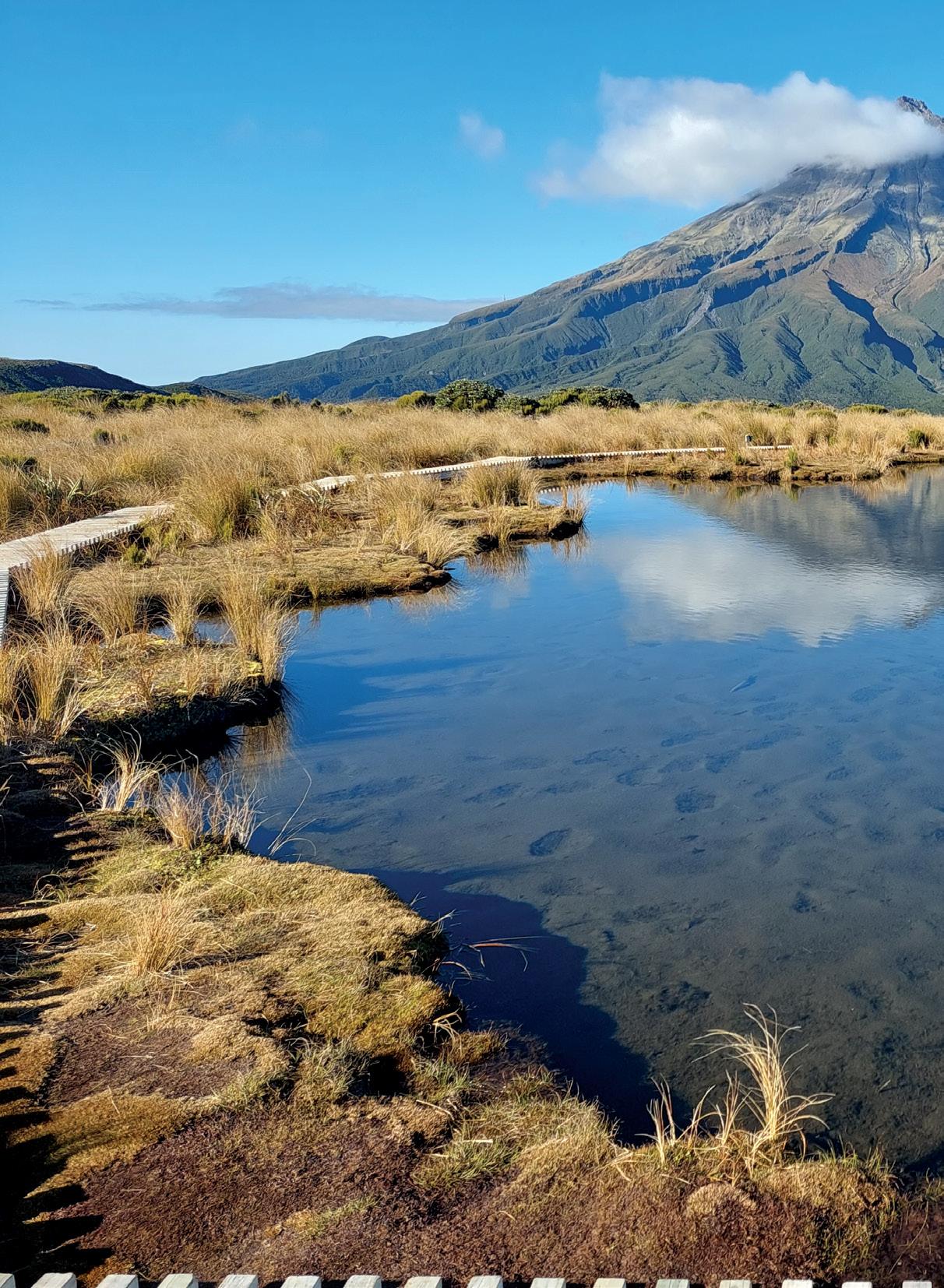
15 minute read
New Zealand Walks: Tantalizing Taranaki 10 New Zealand Walk: Autumn walks in McClaren
Tantalizing Taranaki
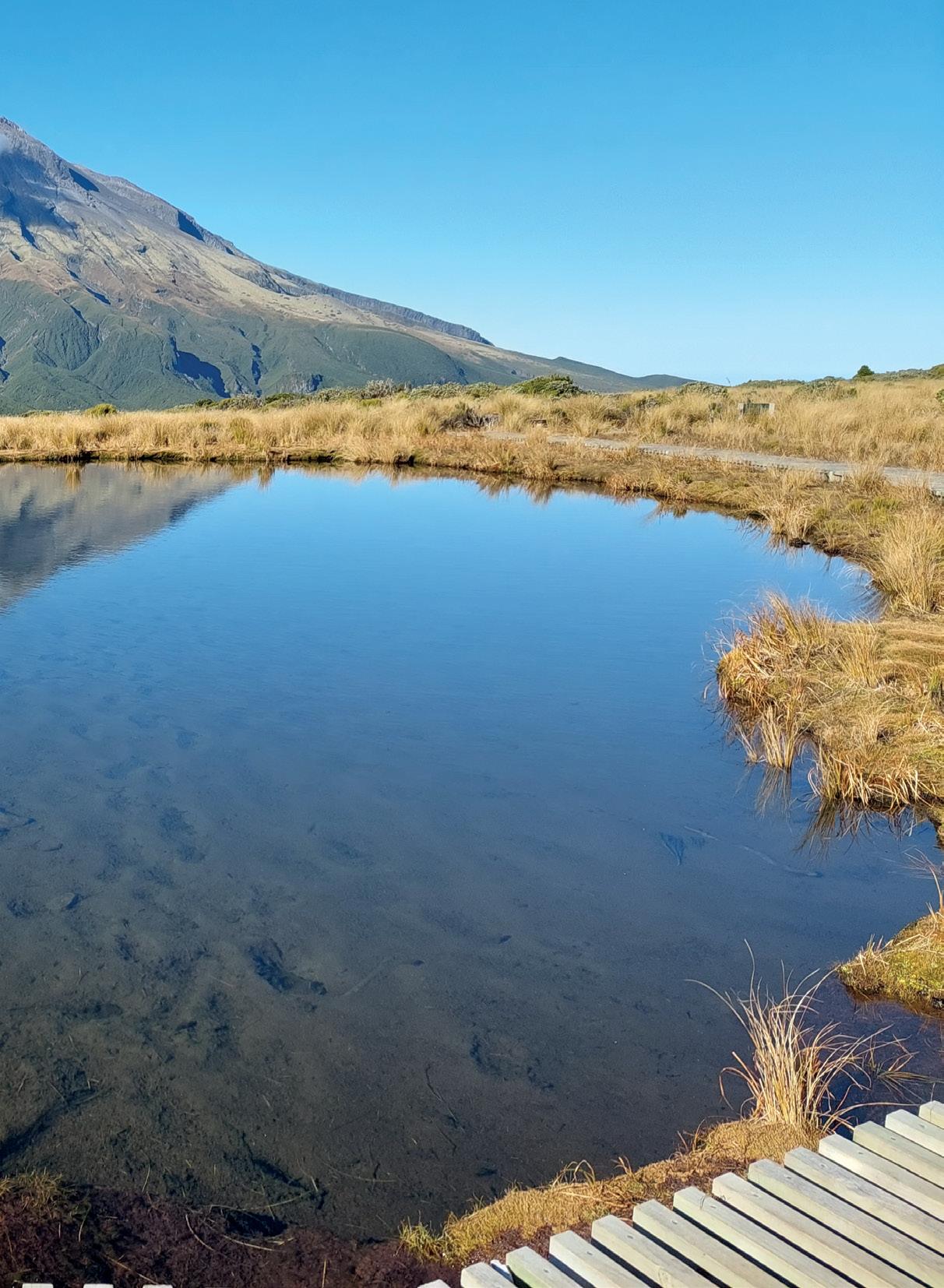
Advertisement
The famous Ruahumoko Tarn with Mt Taranaki in the background.

Tantalizing Taranaki
By Phillip Donnell
Maunga Taranaki (2518m) stands like a lonely sentinel defiantly guarding the region to which he gives his name (meaning “barren mountain”). Maori say he was banished from the company of his fellows in the centre of the North Island for having an illicit affair with the graceful Pihanga, wife of the proud and jealous Tongariro.
This distinctive symmetrical andesite cone dominates the countryside. He’s the latest of a series of volcanoes in a single line from Moturoa south to Kaitake and Pouakai, both now much-eroded remnants of much larger peaks.
Since Mount Taranaki’s most recent activity happened as late as 1620, he is more correctly deemed a dormant rather than extinct volcano, and is well-known for rapidly-changing moods and weather conditions.
Egmont National Park covers a circular area of 33,527ha extending for a radius of 10km from the summit. It is the obvious and unavoidable focus of any walking excursion into the region. However, Taranaki also boasts three marine reserves, iron sand beaches fringed with great surf, wonderful lakes, spectacular parks and gardens, and fantastic museums and galleries. A network of walking tracks links these features and offers a unique perspective of Taranaki’s legendary landscape.
Footsteps Walking Club’s Tantalizing Taranaki day-walks excursion (27 November – 3 December 2022) is an opportunity to go and enjoy much of what Taranaki has to offer, including all the key points of historical interest and natural beauty. Whether exploring the alpine splendour of the mountain tracks, imbibing the emerald swards of rolling farmland, or meandering a path along the dynamic littoral, discovering Taranaki by foot will give you an experience like no other.
Begin with the best of New Plymouth, including tooth-like Paritutu Rock, the award-winning coastal walkway (with the unusual Rewa Rewa Bridge), reflections in Lake Mangamahoe, the famous Pukekura Park (beautifully floodlit at night), and the Te Henui, Tupare or Huatoki trails through picturesque urban valleys.
Venture northwards to the Whitecliffs Walkway, where the ebony sand contrasts with its pristine ivory backdrop. The Three Sisters play with their Elephant at Tongaporatu. At 74m, Mount Damper Falls is the highest single-drop waterfall in the North Island and has become a “must see” for travellers.
You are now ready to “hit the mountain” in four bite-size sections – first its northern flank, then eastern, southern and western slopes.
From the North Egmont Visitor Centre, the very fit and adventurous could attempt a summit climb. An out-and-back jaunt from Mangorei Road to the famous Ruahumoko Tarn is another demanding workout. Most, however, will settle for less strenuous options such as one of the Ngatoro, Veronica, Maketawa or Tahurangi loops, perhaps combined with the Connett Walk or Holly Hut Track Lookout.
Eastern delights emanate from the Stratford Plateau. Mangonui Gorge channels you inexorably to the mountain’s sole skifield. Above: Mt Taranaki in all her glory. from the north Below left: Paratutu Rock.
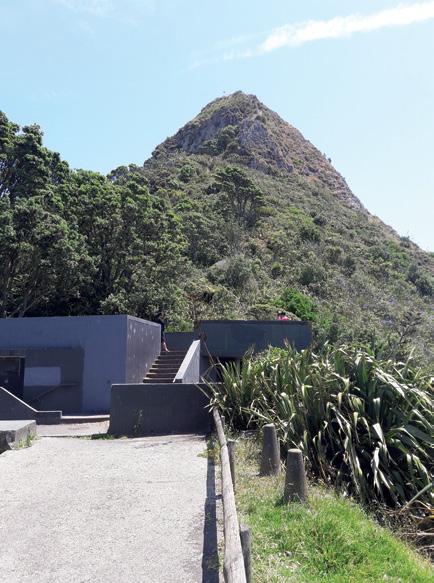
The Enchanted - Waingongoro combo crosses one of the deepest fern-lined canyons in the park. Kamahi, Patea and York Loops can all be traversed in a day, and in the evening you can climb through the predator-proof fence at Lake Rotokare to spot kiwi. The southern slopes of Egmont have a somewhat different origin. When the volcano was active, material thrown up from the crater fell back into it, blocking the main outlet. The forces within, lacking the power to blow out the plug, es-
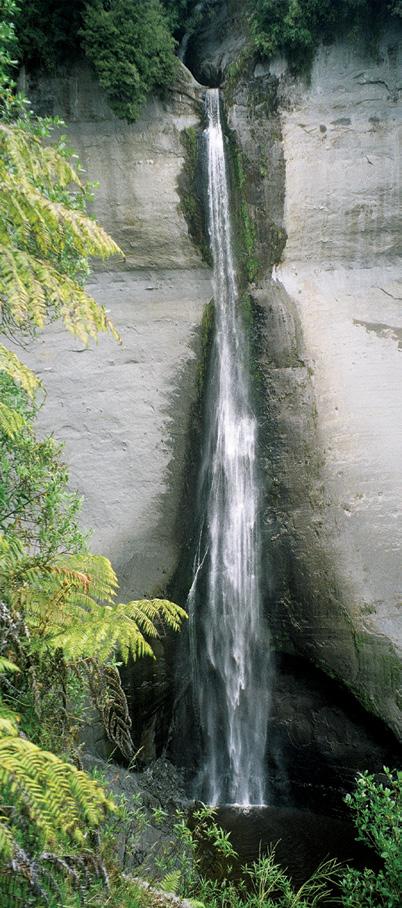

caped through the side to form the subsidiary Fantham’s Peak (1968m), named after Fanny Fantham, who in 1887 was the first woman to climb it.
You can do the same in five to six hours return. Alternatively, shorter walks from the Dawson Falls roadend are equally breath-taking. Konini Dell, Hooker Shelter, Hasties Hill and Kapuni Circuit are worthwhile, but the pick of the bunch is the Wilkies Pool Loop.
Several towns dot the South Taranaki Bight: Patea, Hawera, Manaia, Opunake, Okato and Oakura, These afford convenient café pauses as you explore the western periphery. Long and challenging trails trend upwards from the park boundary to Waiaua Gorge, Kahui Hut and Bell’s Falls.
Alternatively, the dramatic coastline is best sampled via the Ohawe to Waihi Beach Coastal Walkway, taking you past the fortified pa where Maori first lived, cliffs made of 3-million-year old soft papa rock, a wide range of sea life in numerous rock pools, Rangatapu Marae, and the remnants of a pioneer tram trail. Cape Egmont lighthouse and Parihaka are worth a visit.
Above right: The Coastal Walkway is popular with walkers, runners and cyclists. Below left: Mt Dampier Falls.
In 2017 Taranaki was voted by “Lonely Planet” as the second best region in the entire world to visit. They were impressed by the huge variety of attractions in what is a relatively compact area. You will be impressed too.
Why not come and join us next summer for a week of walking which is not only good for body, soul and spirit but also surprisingly kind to the pocket. For details please visit our website www.footstepswalkingclub.com or contact us at 021 172 3244/ footstepsanz@gmail.com.

Autumn walks in McClaren Falls Park

Ouch! Sore feet while walking?
Hikers Wool is 100% New Zealand wool. Cushion your feet to prevent pain, rubbing and blisters.
Buy online or at selected stockists
For more info visit www.hikerswool.co.nz

Above: Reflections from the lakeside track at McClaren Falls Park.
Autumn walks in McClaren Falls Park

Walking New Zealand
magazine is available at all


Freephone 0800 walking
to subscribe to Walking New Zealand magazine Only $84.50 for 12 months
Autumn walks in McClaren Falls Park
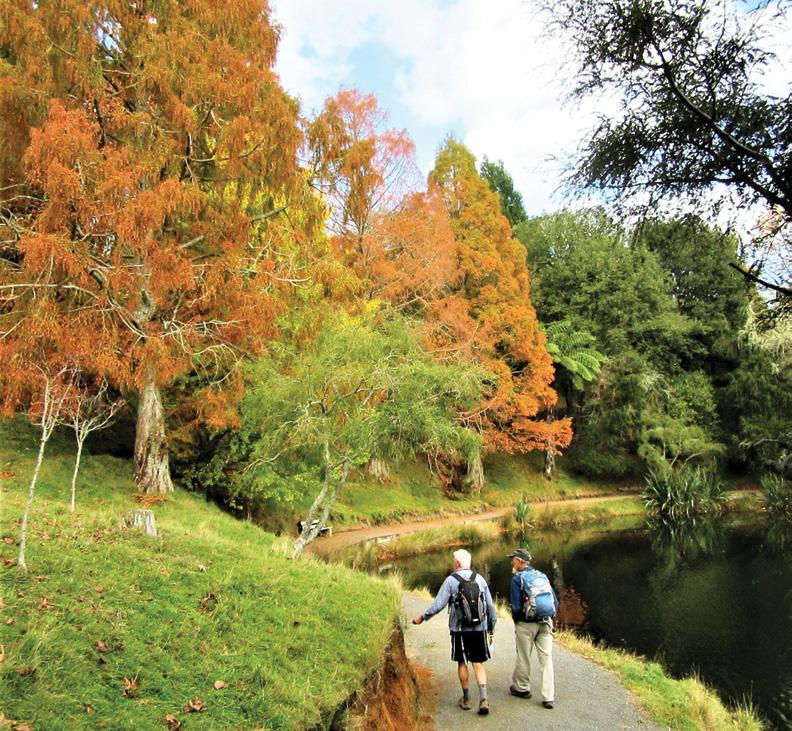
By Barbz Lowther
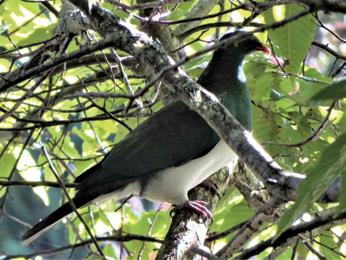
The walks in Mcclaren Falls Park are lovely at any time of the year, but stunning in Autumn, when all the exotic trees show their colours.
Lake Mcclaren was created in 1925 after the construction of a dam and power station; and 190 hectares of land beside the lake, was set aside for a park. Planting began in the 1960’s to create one of the best collections of trees in the North Island, which is now home to many native birds.
We spotted several kereru, and saw lots of fantails and tuis flitting around.
Mcclaren Falls park is only 15 min-
Above left: Along the Lakeside
Track. Above right: One of the many Keruru in the park. Below left: At the waterfall where glow worms can be seen at dusk. Below right: In the shade on the Lakeside
Track.
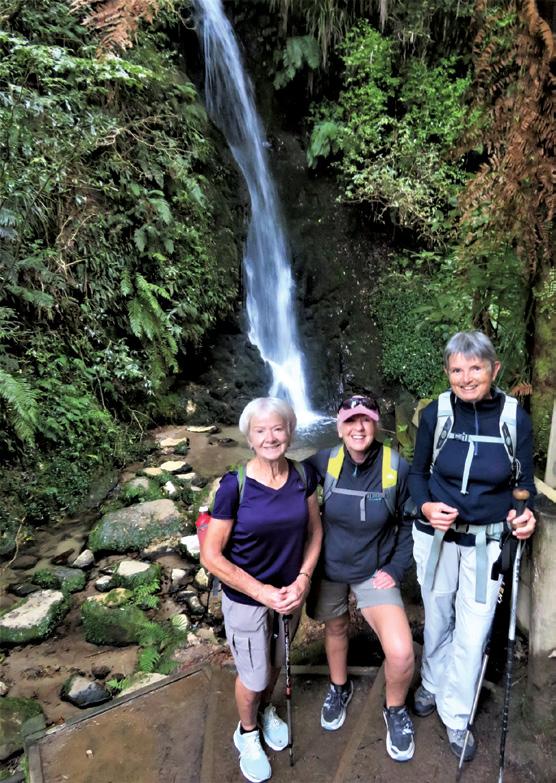



utes drive from Tauranga. The falls can be viewed from a bridge at the park entrance. They are fascinating, ranging from a gentle flow to a stunning display of raging white water, depending on the amount of rain in the area. Not far from here, is a car park and visitor centre, with displays of trees and birds in the park.
There are a variety of walks, ranging from 15 minutes to a couple of hours in length, offering something for all levels of ability.
One of the most popular walks, is the lakeside track, which follows the lake edge to the top of the lake. It is flat and easy and offers lovely views of trees reflected in the water, and swans and ducks are never far away - magic photo opportunities.
Another option, is the waterfall track, a short loop through native bush to a small waterfall. This is fun to walk at dusk, when glow worms can be seen.
An interesting loop from the waterfall car park, takes you up the Nikau Track to the top paddocks, over Pin Oak campsite, where camping is permitted, and on to top flat.
In amongst the trails is a disc golf course for family fun. A left turn takes you through Punga Grove to Pine Tree Knoll, with its beautiful views over the park.
You can then follow Sunrise Track back down to the lake, and walk past Cherry Bay, a pretty picnic spot, and back to your car, in just over an hour.
Another interesting walk takes you beyond the equestrian area, through native bush to ‘the 3 sisters’ - three large Rimu trees. Maps are available at the Visitor centre.
You can walk as long or as little as you like, and end your ramble with a coffee in a tranquil outdoor setting, at the cafe. Above left: Swan and cygnet at the lake edge. Above right: Crossing the bridge at Cherry Bay. Middle right: Signs to remind walkers to consider the 300 sheep grazing in the park.


By Juliet Gibbons
Not all who wander are lost

New Zealanders have always been great travellers.
The ‘OE’ has been a rite of passage for many, drawing Kiwis to explore far flung corners of the globe. But these days a new phenomenon, the ‘DE’ seems to have taken on greater appeal.
Otherwise known as the ‘domestic experience’, this emerging tradition is more than likely due in no small part to a global pandemic, conflict in Europe and a climate conversation which has some thinking twice about international travel.
It is also a renaissance to a simpler time and a great chance for people to reconnect with nature, says Juliet Gibbons, the co-owner of Wilderness Guides based in Picton.
“I think a lot of New Zealanders have fallen in love with their own country during what has been a difficult couple of years. That saying has become true – not all who wander are really lost,” she says.
“Kiwis have got out and about, when they could, explored their backyard, done something new and realised what a great country we live in.”
Juliet and her husband Steve have operated Wilderness Guides for 23 years this October and she says prior to Covid, life was going along very well.
“We had just celebrated the 20th anniversary of the business with our staff and life could not have been better. A few months on and we were wondering where to from here.”
The couple had had tough years before. In their first year of business, there was a severe drought that affected many parts of Marlborough including the Marlborough Sounds. Parts of the Queen Charlotte Track were forced to close due to fire risk and being their first year, it was a financial disaster and almost forced them out of business.
“Somehow we managed to survive back then and now, with support of family, staff and New Zealanders who have continued to travel and explore their backyard, we have come through,” she said.
“We have welcomed more New Zealanders than ever through our doors to experience the Queen Charlotte Track. It has been humbling to have this support and exciting
Above: Covid has created an opportunity for us to do something new.


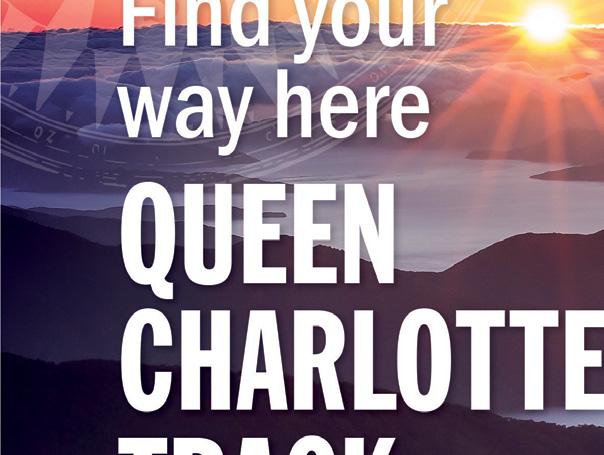
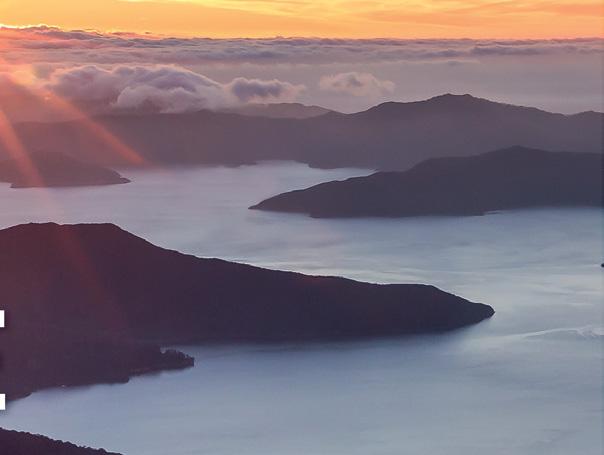





Not all who wander are lost
to be showing fellow Kiwis what a fantastic place the Marlborough Sounds is.”
Juliet is confident Kiwis will continue to travel domestically despite the opening of New Zealand’s borders to the rest of the world and international travel resuming. “It is going to take a while for us all to feel relaxed about travel – and perhaps we won’t ever see that same scale of travel again. Perhaps that’s not a bad thing,” she says.
Ranging from one day to many days in length a trip on the spectacular Queen Charlotte Track with Wilderness Guides is about good times, relaxation, exploration, conservation, and great local food.
Moreover, Juliet says, the setting, in the geologically unique Sounds, a labyrinth of drowned river valleys and sheltered peninsulas, waterways and islands which stretch over 1500km, is unique in the world.
“Meretoto/Ship Cove, where the Queen Charlotte Track begins, is a site of both national and international significance where the first sustained contact between the New Zealand Māori and the European took place,” she says. It was here at this snug cove in the outer Queen Charlotte Sound he replenished water supplies, rested his men, and repaired his ships on five different visits between 1770 and 1777.
Despite the Queen Charlotte Track not being part of the Great Walk network, its popularity has remained strong with New Zealanders.
“We just do what we do here in the Marlborough Sounds. Great walks really are in the hearts and minds of those who experience them and without a doubt, the Queen Charlotte Track is one of the best,” Juliet says. The couple have ■ spent more than two decades sharing their backyard with thousands of visitors to the region every year and sending them home with fond memories of the Marlborough Sounds.
“We have made life-long friends with so many customers, staff, and business colleagues along the way. Tourism is a rewarding and positive industry to work in.”
“Our kayak, bike and walk tours totally immerse people in the Marlborough Sounds environment, be it walking or biking along the Queen Charlotte Track or The Link Pathway or kayaking around the beautiful
Above left: Go for a wander, you never know what you may find – perhaps even yourself. Below right: Reconnecting with nature has never been so important.
The H215 Professional 4 Function Pedometer
The H-215, 4-function pedometer is a superb, reasonably priced pedometer that counts steps, calculates distance, calories burned and has a 12/24 hour clock. This is the model that has sold over a quarter of a million worldwide. It has the largest display of any pedometer we tested and is very accurate. Dimensions: (L) 5.6 * (W) 3.7 * (t) 2.7 cm Price only $36.95 plus $7.00 P&P

Phone 0800-925-546 for bulk prices Available now from:
Walking New Zealand Shop
P O Box 1922, Palmerston North - Phone 0800-925-546 Fax 06-358-6864 or email walkingnz@xtra.co.nz. www.walkingnewzealand.co.nz

bays and coves of Queen Charlotte Sound. Our staff are our biggest asset – they love their job, and it shows as they share this place with our guests, be they locals or visitors to the region,” said Juliet.
“I guess the unique thing about Wilderness Guides Marlborough Sounds is us and the positive work environment we create for our team to ensure we give the best possible experience to all the holidaymakers that come through our doors. We have always been completely dedicated to the concept of customer first.”
The couple’s children Ben (15) and Lizzie (12) are now helping in the business as well and Juliet says the couple have a keen sense of responsibility to leave a positive legacy in the Marlborough Sounds for future generations.
“We feel that our industry can be leaders in this, and it is something we are working on to find the right way to do so. Overseas visitors see in a heartbeat what a special place the Marlborough Sounds is – we as locals have the responsibility to ensure it stays that way and is sensitively managed while constantly balancing the various competing interests including tourism,” she said.
There are a lot of great conservation initiatives already underway in the Sounds such as Kaipupu Point, Sounds Restoration Trust, Picton Dawn Chorus, and the Endeavour Inlet Conservation Group.
“This is a unique opportunity that we all have as New Zealanders to reconnect with nature – and to reshape our visitor industry with protection and enhancement of our unique environment at its core. We are working on some important initiatives with like-minded others to see this happen,” says Juliet. Above top: A new dawn for New Zealanders’ and their love affair with travel.

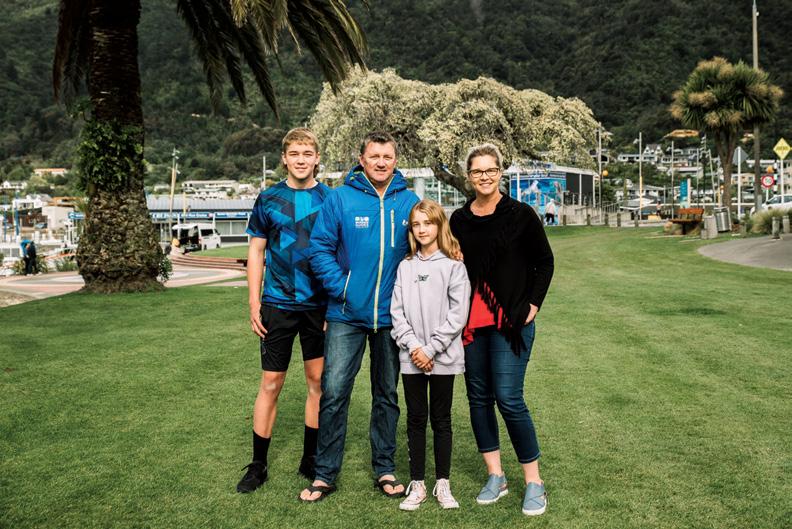
Above left: Leaving a positive legacy in the Marlborough Sounds motivates Steve and Juliet Gibbons, with their children Ben and Lizzie.
Ouch! Sore feet while walking?

Hikers Wool is 100% New Zealand wool. Cushion your feet to prevent pain, rubbing and blisters.
Buy online or at selected stockists
For more info visit www.hikerswool.co.nz

Boots Packs
Rainwear
All your tramping essentials One shop ~ Since 1988








